Otsuka – MDR-Tuberculosis R&D


Health needs
TB bacteria are so resilient that patients must take a regimen of several different medicines for anywhere from six months to a year. In the case of drug-resistant strains such as multidrug-resistant TB (MDR-TB), treatment can often last twice as long.
Initiative’s objective
- Lead the discovery and development of new TB technologies.
- Evaluate the safety and efficacy of a novel compound, delamanid, in the treatment of multidrug-resistant tuberculosis (MDR-TB).
- Strengthen clinical trial capacity and infrastructure in selected countries affected by TB.
Initiative’s description
As a recognized leader in TB R&D, Otsuka is committed to helping eliminate this devastating disease. For more than 30 years Otsuka has made TB research a priority, including strengthening clinical trial capacity and infrastructure in selected countries affected by TB. These investments that are over USD 450 million have made Otsuka the current top private funder of TB drug development in the world.
In 2002, Otsuka experienced a breakthrough in its TB research with the discovery of delamanid, a nitroimidazole, which has subsequently received its first regulatory approval from the European Medicines Agency in 2014 as an oral treatment against adult pulmonary MDR-TB. Delamanid is the first from a new class of compounds that inhibit mycolic acid biosynthesis with specificity to mycobacterium TB. Since 2015, it has been included in the World Health Organization’s Essential Medicines List.
The safety and efficacy of delamanid is currently undergoing further evaluation in several countries in a double-blind, placebo-controlled Phase III trial. The trial includes six months of treatment with delamanid as part of a full course of treatment with an optimized background regimen (OBR) and includes HIV co-infected MDR-TB patients.
Additionally, the company has initiated a paediatric investigation plan consisting of open-label, multi-center PK and safety trials of delamanid in children with MDR-TB in four groups of descending age from less than 18 years to birth. For the youngest groups, a novel child-friendly dispersible formulation of delamanid is being used. The studies are taking place in the Philippines and South Africa.
Impact
- Otsuka is the largest private funder for TB drug development totalling over $470, 370, 725 since 2005 (WHO, 2017)
- Otsuka has supplied over 5,000 patient courses of delamanid for treatment in 70 countries for compassionate use, expanded access programs, or under normal programmatic conditions, including 25/30 WHO High MDR-TB burden countries
Lessons for success
Developing Innovative Funding Solutions
The challenge of multidrug-resistant tuberculosis is too large for any single company, institution or government to take on alone. It requires multiple collaborations with public, private and non-profit partners to develop new innovations and successfully scale them up in the field. Identifying these partnerships and generating commitment to sustained funding for R&D can be a challenge which requires active engagement from donors and other funding institutions.
Building Market Demand
Developing new innovations in neglected diseases is not sufficient. It requires a concerted effort to build market demand and stimulate uptake. This is especially true in the field of paediatrics, which are often overlooked. In TB treatment, children are often neglected as they are not seen as integral to TB transmission rates and diagnostic tools to detect TB in children are lacking. This makes identifying market potential and stimulating R&D particularly challenging. Working with multiple partners on market-shaping activities are critical, particularly very early in the development process.
